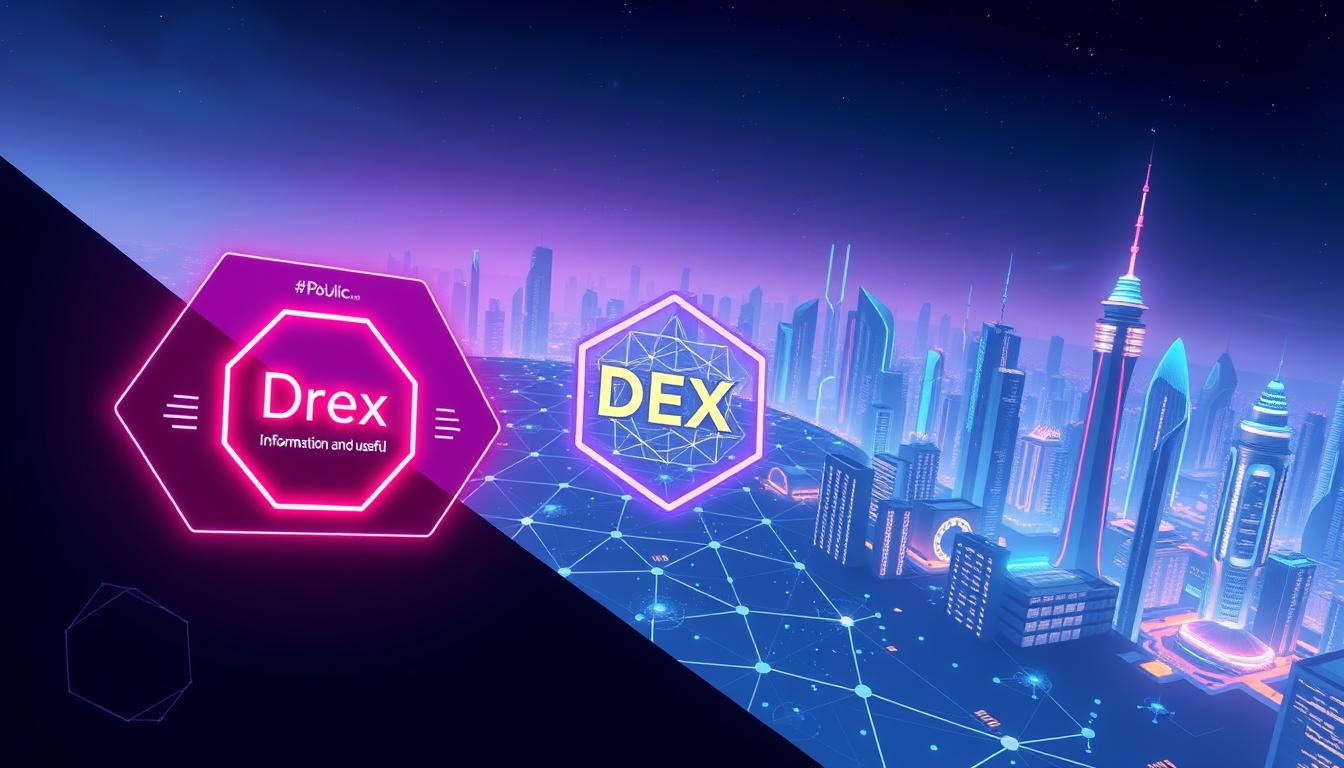Top Decentralized Exchanges
Surprising fact: across DeFi, 1,011 platforms handled about $5.27B in 24-hour trading volume — roughly 6.7% of total crypto market activity.
You came here to compare exchanges that let you trade from your own wallet without a custodian. This short guide shows which dexs fit your goals for speed, fees, and token access.
We explain how each exchange type works, how you connect a wallet, and what to check before you trade. Expect plain-English tips for U.S. users on taxes, records, and transaction confirms.
Security and privacy are central: you’ll learn what staying in control of your keys really means and how liquidity, routing, and execution shape prices and fees.
By the end, you’ll have concise information and clear criteria to pick a starting platform and make your first trade with fewer surprises.
Key Takeaways
- Over 1,000 DeFi platforms show strong adoption, with daily volume signaling active market interest.
- DEXs let you trade from your wallet; learn connectivity and custody trade-offs first.
- Understand liquidity pools, routing, and fees to improve execution and costs.
- Check chain support, liquidity depth, and feature sets to match your asset needs.
- Prioritize security: control keys, verify contracts, and keep records for tax reporting.
Discover the best way to trade crypto privately and securely on decentralized exchanges
Want a private, in-wallet way to trade crypto without handing control to a third party? A decentralized exchange connects your wallet to smart contracts on a blockchain so you trade from your own address.
You keep custody while a contract handles the swap. That means no sign-ups or KYC for most users, and you can buy sell tokens with fewer roadblocks.
The trade-off is clear: you avoid custodial risks but still pay network fees and handle your own seed phrase. Every transaction is public on-chain, so privacy means fewer intermediaries—not invisibility.
- Control private keys: you hold private keys, so your funds depend on your wallet hygiene.
- Fast access: wallets like MetaMask, Trust Wallet, and Coinbase Wallet make connecting and confirming transactions simple.
- Asset routing: for Bitcoin you can use wrapped tokens on Ethereum or native swaps via Thorchain without need for wrapping in some cases.
- Check contracts: verify addresses to avoid look-alike tokens and reduce scam risk.
In short, decentralized exchanges give you control, access to new token markets, and more privacy. But you also accept responsibility for security and record-keeping. Learn how your wallet works before you trade.
How we evaluate the best DEX platforms for your trading

We rate each platform by how well it protects funds, moves orders, and keeps costs low. That simple checklist guides our deeper tests so you can choose with confidence.
Security, custody, and smart contracts you can trust
Security first: we look for audited smart contracts and clear disclosures. A short, public history of safe operation lowers risk on the blockchain.
Custody matters: because you hold assets in your wallet, we check how each platform explains recovery, permissions, and phishing risks to users.
Liquidity, trading volume, and market depth
AMMs use liquidity pools supplied by users; order-book models like dYdX match trades quickly. We compare pool sizes, spreads, and routing to find platforms with deep liquidity and tight pricing.
Real, sustained trading volume across pairs signals better execution and less price impact when you trade.
Fees, slippage, and wallet experience
We measure base fees, gas costs, and slippage controls. Layer 2 networks and concentrated liquidity models often lower costs and improve fills.
Wallet experience: smooth connects, clear permissions, and fast confirmations help you avoid mistakes at the moment of exchange.
- Performance: consistent uptime and predictable confirmations.
- Token info: visible contract addresses and liquidity sources to avoid fake listings.
- Cross-chain reach and governance: broader asset access and solid incentives favor long-term platforms.
Top Decentralized Exchanges: our product roundup of leading DEXs

Below are concise profiles of leading platforms to help you weigh liquidity, fees, and supported tokens. Each entry notes what the platform does best so you can decide where to trade and which wallets work smoothly.
Uniswap
Uniswap is the go-to AMM for ERC‑20 tokens. It uses concentrated liquidity to improve capital efficiency and lower slippage on major pairs.
dYdX
dYdX gives an order-book feel with decentralized control. Expect fast execution, advanced order types, and on-chain settlement for serious traders.
Curve Finance
Curve specializes in stablecoin and wrapped asset swaps. It minimizes price impact when you move like-kind assets.
PancakeSwap
PancakeSwap runs on BNB Chain and offers low fees, yield options, and a user-friendly interface for budget-conscious users.
1inch & Kyber
1inch and Kyber aggregate liquidity to find better execution across many platforms. Use them to reduce fees and slippage on larger orders.
Solana venues: Jupiter & Raydium
Jupiter routes trades quickly with tiny transaction costs. Raydium blends AMM pools and order-book liquidity for deeper fills on popular Solana tokens.
Thorchain
Thorchain enables native cross-chain swaps, including Bitcoin, so you can move assets between chains without wrapped tokens.
Compare supported tokens, on-chain liquidity, base fees, and wallet compatibility before you buy sell to ensure the best trade execution.
Most Read:- Navigating Crypto Market Volatility: Tips for New Investors
Decentralized exchanges vs. centralized exchanges: what you gain and what you trade off

Before you pick where to trade, weigh control against convenience. This section lays out clear advantages of a decentralized exchange and the trade-offs when compared with centralized exchanges.
Advantages you get with a decentralized exchange
You keep custody of your keys and funds, so custody stays with you and fewer gatekeepers control access.
Broader token access: new cryptocurrencies often appear on DEXs first, letting you find fresh assets sooner.
Privacy benefits: many DEXs avoid KYC, reducing data collection and single points of failure unlike centralized exchanges.
Trade-offs compared to centralized exchanges
CEXs use order books, offer leverage, and make onboarding simple. That convenience often includes fiat rails, advanced order tools, and customer support.
- Risk: CEX custody concentrates funds and has a history of hacks.
- Fees & pricing: DEX base fees can be low but gas varies; CEXs may add withdrawal or trading fees.
- Liquidity: major CEXs host deep books; DEX liquidity depends on pair and chain, which can raise price impact for big trades.
- Strategy fit: active traders may prefer CEX tooling; self-custody users favor DEX composability and control.
| Feature | Decentralized exchange | Centralized exchanges |
|---|---|---|
| Custody | User-held keys | Platform-held wallets |
| Onboarding | Wallet connect, no KYC (often) | Fiat rails, KYC required |
| Liquidity | Variable by pair/chain | Generally deeper order books |
| Support | Docs and communities | Customer service and disputes |
Fees, liquidity pools, and price impact: making sense of the market mechanics
Understanding how fees and pool depth shape your final fill helps you make smarter trades. This section explains the math and choices behind common AMM markets and practical steps to limit cost and slippage.
How AMMs and liquidity providers power markets
Automated market makers use formulas and paired pools to set prices. Liquidity providers deposit tokens to a pool and earn a cut of trading fees.
Providers accept impermanent loss if token prices diverge, so supplying assets is a different risk than simply trading.
Managing slippage and understanding price execution
- Your cost = protocol fees + gas or transaction fees. On Solana, per-trade fees can be under $0.01.
- Aggregators route across platforms to split orders and reduce slippage for larger trades.
- Layer 2 rollups cut fees and speed up transactions on Ethereum-like networks.
- Use slippage controls to cap execution variance; tight caps protect price but may cause failed swaps in volatility.
- Always verify token contracts and review wallet approvals to avoid lookalikes and reduce exposure.
| Mechanic | Impact on price | Typical cost | What you can do |
|---|---|---|---|
| Pool depth (liquidity) | Tighter spreads, less price impact | None direct; affects slippage | Split large trades or use aggregators |
| Protocol & transaction fees | Raises total trade cost | Varies by chain; Solana | Choose Layer 2 or low-fee chains |
| Routing across pools | Improves final price | May add minimal extra gas | Use aggregator tools |
| Impermanent loss (LPs) | Affects liquidity provider returns | Opportunity cost vs. HODL | Consider single-sided or stable pools |
Your first trade on a decentralized exchange: a quick, user-friendly guide

Ready to make your first on-chain swap? This short guide walks you through a safe, simple trade and gives U.S.-specific notes so you keep good records.
Choose and secure your wallet
Pick a wallet you like: MetaMask (browser/mobile), Trust Wallet (mobile), or Coinbase Wallet (mobile/browser). Write down your seed and store it offline.
Secure your private keys and never share your seed phrase. That way you keep control private keys and custody of your assets.
Connect, select pair, and confirm
- Fund the wallet with the right gas token (for example ETH) so you can cover transaction fees and approvals.
- Connect to the DEX, choose your pair, set slippage, and check price impact before you confirm.
- Start small to test the flow, confirm the transactions, and verify the receipt on a block explorer.
U.S. notes: records, fees, and risk
DEXs don’t report to the IRS. In the U.S., crypto trades are taxable events, so keep date, cost basis, and proceeds for every swap.
Time swaps when networks are quieter to save on gas or use an L2 to reduce costs. Verify contract addresses to avoid copycat tokens and revoke approvals you no longer need.
What today’s data says about DEX adoption, volume, and market share
Current data highlights how liquidity and users cluster around a few active platforms. That pattern affects price execution and the routes you should pick when you trade.
Daily trading volume snapshots and liquidity concentration
Quick snapshot: about 1,011 active platforms record roughly $5.27B in 24-hour trading volume, or ~6.7% of total crypto market activity.
What this means for you: liquidity is concentrated among a handful of exchanges. Routing through leading dexs or aggregators typically gives better fills and lower price impact for large orders.
Why usage grows despite market cycles
Adoption persists because users value custody, composability, and permissionless access on-chain. Faster chains, Layer 2s, and smarter routing lower costs and invite more participation.
- High-volume pairs deliver tighter spreads; long-tail tokens need smaller, staged orders.
- Stablecoin and cross-chain liquidity speed movement of assets and raise daily activity.
- Blockchain transparency and aggregator tools help you spot windows of deeper liquidity.
Trends shaping the next wave of decentralized exchanges
New infrastructure is reshaping how you trade on-chain, turning swaps into near-instant app-like actions.
Layer 2 scaling and fast order-book venues
Layer 2 rollups and high-throughput chains cut fees and speed confirmations. That makes on-chain trading feel more like a responsive web app.
Order-book platforms such as dYdX deliver centralized-style speed while you keep custody. You get advanced orders without surrendering control.
Cross-chain swaps and concentrated liquidity advances
Concentrated liquidity places capital where trades occur, improving depth and execution for major pairs. That helps reduce price impact when you move larger amounts of tokens.
Native cross-chain solutions like Thorchain let you move cryptocurrencies across chains without wrapping or centralized bridges. This reduces complexity and lowers risk for many users.
- Better token discovery and risk signals help you avoid scam contracts and find real liquidity.
- Wallets are adding clearer approvals and revocation tools to protect your transactions.
- Expect more automation: smart order routing, LP management, and portfolio features inside the swap flow.
Bottom line: these trends make dexs more usable and more competitive with centralized alternatives, while keeping the custody advantages you value.
Conclusion
Use the criteria here to narrow options and make a low-risk first swap on a chain you trust.
You now have a clear framework to compare a cryptocurrency exchange and spot where liquidity, fees, and routing matter most for your crypto trades. Start with a small trade to learn the wallet flow and confirm prices.
Non-custodial trading on a decentralized exchange keeps assets in your wallet while tapping global liquidity. Leading venues capture most daily volume, so follow data to limit price impact and time swaps wisely.
Combine a fiat-friendly cryptocurrency exchange for onramps with DEX swaps for token access. Keep records for U.S. taxes, verify contracts, and revisit your shortlist as platforms and market features evolve.
Ready to begin? Pick a platform, choose a chain, and make a low-stakes buy sell to turn knowledge into action.


